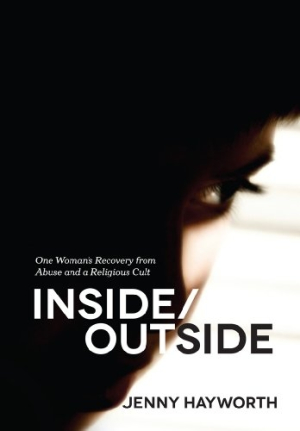
Inside/Outside
One Woman's Recovery from Abuse and a Religious Cult
Clear perspectives from a child’s point of view provide imagery that is both unsettling and effective.
Childhood sexual abuse is rarely an isolated incident. Abuse suffered by one child often echoes throughout the child’s family, though it may be carefully hidden from view. This was the case for Jenny Hayworth, who could not reveal her suffering as a child. As an adult, though, she is able to tell the story of abuse perpetuated in her family and their religious community. Her candid memoir, Inside/Outside: One Woman’s Recovery from Abuse and a Religious Cult, takes full account of her dysfunctional family dynamics and their oppressive religious teachings in the hopes of changing these patterns for herself and others in the future.
As testimony to the intergenerational nature of abuse, Hayworth opens with the revealing words of her grandmother, talking about her own father: “The day my mother died, I went to bed with a knife, and he never bothered me again.” This riveting line sets up the expectation that the rest of the memoir will be equally raw and visceral.
Instead, when Hayworth turns to her own story, it’s from a distance. She proceeds in chronological order, beginning with her colicky infancy in the arms of her depressed mother, but she always assesses the situation from her adult perspective. “My mother told me later,” writes Hayworth, “she believed she was suffering from clinical depression brought on, no doubt, by moving to a new country; not knowing anybody; the death of her mother; the absence of her husband; worry regarding his safety; coping with two small, active children; and issues to do with having grown up with an alcoholic father.” All of this information is relevant, but Hayworth’s narrator-from-the-future voice can distract from the scene at hand.
Hayworth is perhaps overly comprehensive in her autobiographical details, which include a section on extended family and their dynamics, as well as anecdotes from childhood that, while part of Hayworth’s experience growing up, add little insight into the issues of sexual abuse and religious repression that are at the heart of her story. Her experience comes through most clearly in her detailed and often graphic accounts of abuse by family members, rape by a stranger, and the near-abduction of her own children. Hayworth vividly sets the stage for each of these incidents; for example, she gives a clear picture of a child’s perspective from the black-and-white tiled floor in her grandfather’s bathroom where she was abused as a young girl. It’s an unsettling but effective point of view.
While Hayworth’s family’s religion plays a significant role in her upbringing—they were committed Jehovah’s Witnesses—she doesn’t focus on this aspect as much as her title might suggest. She shares specifics of how young children were trained to hold still for hour-long meetings, for instance, but doesn’t explore how that training felt to her in particular. There are some poignant moments when Hayworth realizes that her own parenting mistakes likely stemmed from the church’s teachings, but she doesn’t paint a consistently clear picture of day-to-day life in the community.
What keeps the pages of Hayworth’s life story turning is her honesty, tenacity, and sheer will to survive through an astounding number of setbacks. Inside/Outside proves the resilience of the human spirit and shows that the cycle of abuse can indeed be broken.
Reviewed by
Sheila M. Trask
Disclosure: This article is not an endorsement, but a review. The publisher of this book provided free copies of the book and paid a small fee to have their book reviewed by a professional reviewer. Foreword Reviews and Clarion Reviews make no guarantee that the publisher will receive a positive review. Foreword Magazine, Inc. is disclosing this in accordance with the Federal Trade Commission’s 16 CFR, Part 255.
